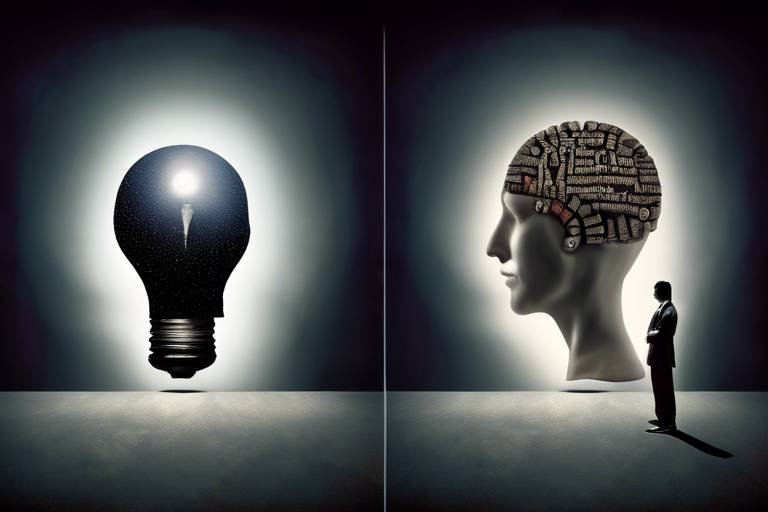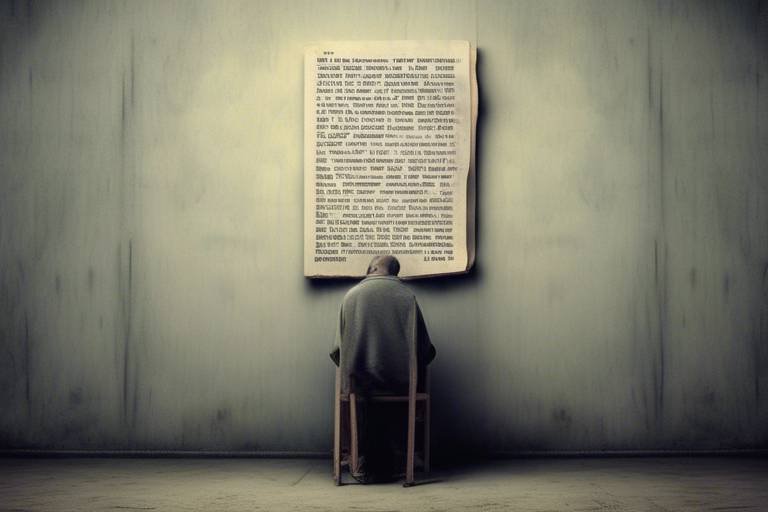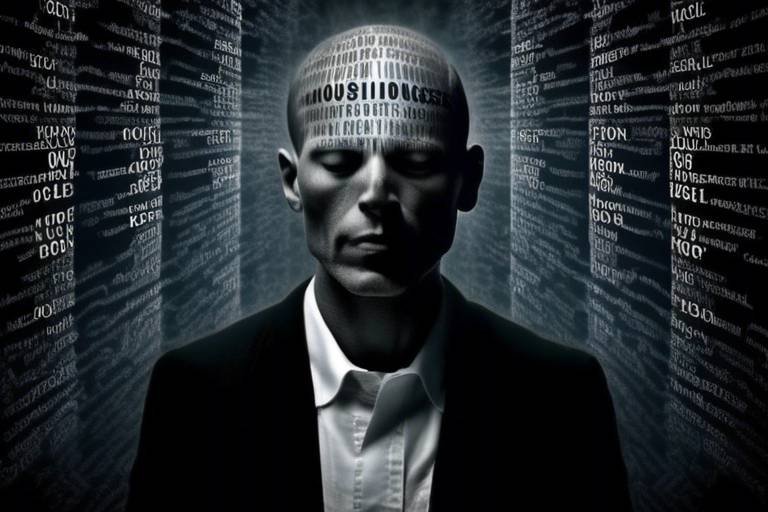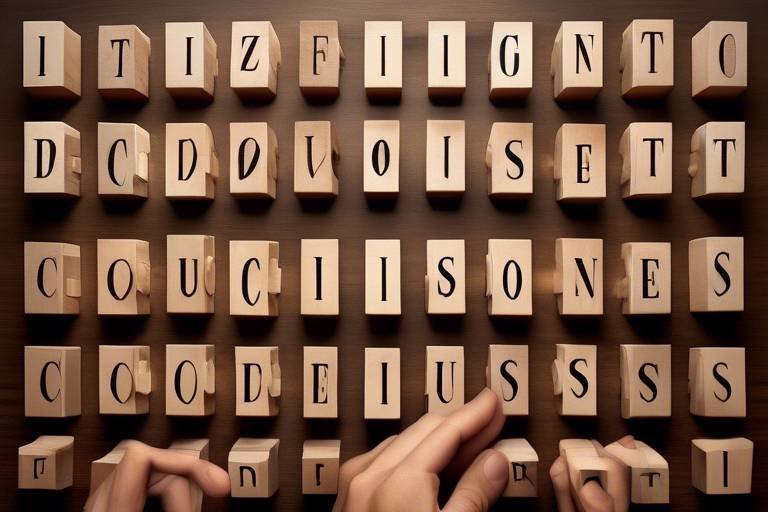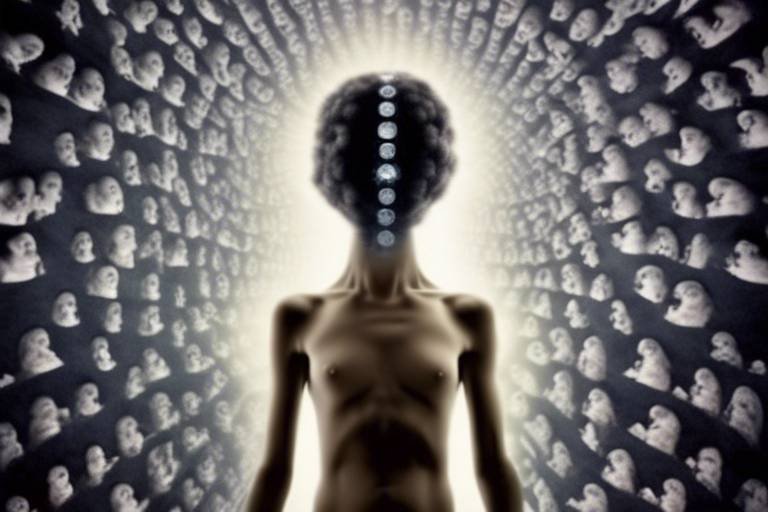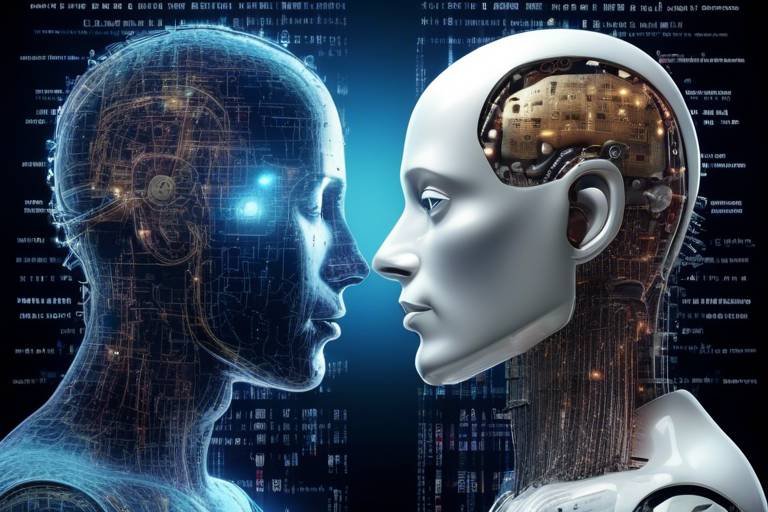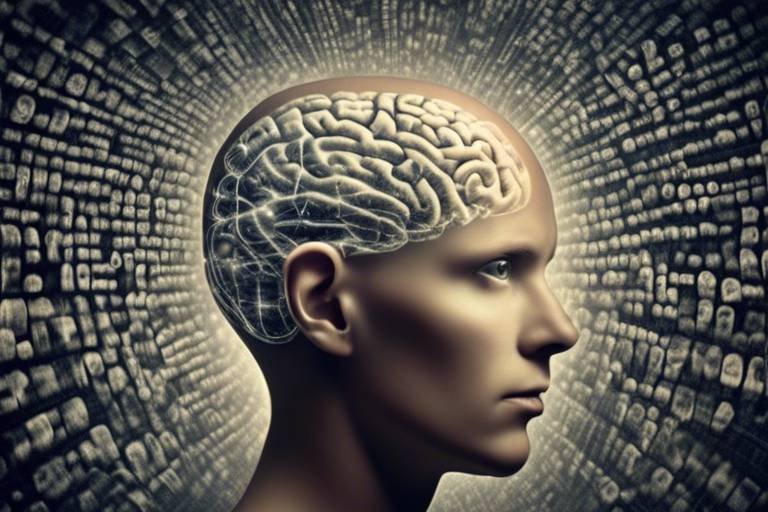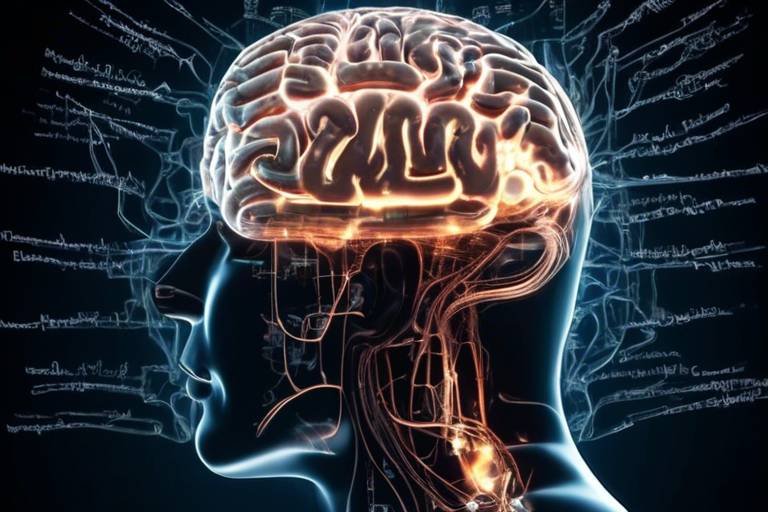Probing Into the Concept of Collective Unconscious
The idea of the collective unconscious is a fascinating journey into the depths of the human psyche, where shared memories and experiences reside, waiting to be explored. Imagine a vast ocean that connects us all, filled with the remnants of our ancestors' thoughts, feelings, and dreams. This ocean is not just a metaphor; it’s a profound concept introduced by the Swiss psychiatrist Carl Jung. He believed that beneath our individual consciousness lies a deeper layer that binds humanity together through universal symbols and archetypes.
So, what exactly does the collective unconscious entail? It’s more than just a psychological theory; it’s a lens through which we can understand our behaviors, beliefs, and cultural expressions. Think of it as a treasure trove of shared human experiences that transcends time and geography. From the myths we tell to the symbols we cherish, the collective unconscious shapes our identities and influences our decisions in ways we often don’t realize.
As we delve deeper into this intriguing concept, we’ll uncover its origins, key components, and the significant implications it has for psychology and culture. We’ll explore how the collective unconscious manifests in our daily lives and how it serves as a guiding force in both individual and societal behavior. Are you ready to embark on this enlightening journey? Let’s dive in!
The roots of the collective unconscious can be traced back to Jung's extensive studies of mythology, religion, and psychology. He proposed that while our individual consciousness is shaped by personal experiences, the collective unconscious is a reservoir of shared human experiences that dates back to the dawn of humanity. This idea challenges the notion that our psyche is solely constructed from personal memories and suggests that we are all connected through a shared psychological heritage.
Jung's exploration of the collective unconscious was influenced by various philosophical and spiritual traditions. He drew from Eastern philosophies, ancient myths, and even the works of fellow psychologists. This blending of ideas led him to propose that the collective unconscious is composed of archetypes, which are innate, universal symbols and themes that resonate across cultures. These archetypes, such as the Hero, the Mother, and the Shadow, serve as templates for human behavior and experience, allowing us to connect with one another on a deeper level.
At the heart of the collective unconscious lie its essential elements: archetypes, symbols, and myths. These components are the building blocks of our shared human experience, influencing not only our personal narratives but also the cultural expressions that shape our societies. Understanding these elements is crucial for grasping the full significance of the collective unconscious.
Archetypes are universal, recurring symbols and themes that emerge across different cultures and historical contexts. They are like the characters in a play, each representing a specific aspect of the human experience. For example, the Hero archetype embodies courage and the quest for identity, while the Wise Old Man represents wisdom and guidance. These archetypes are not just abstract concepts; they manifest in our literature, art, and even in our dreams.
Throughout history, various cultures have depicted similar archetypes, showcasing their universal nature. Consider the following examples:
- The Hero: Found in stories from Hercules to Harry Potter, this archetype represents the struggle against adversity.
- The Mother: A nurturing figure present in countless myths and tales, symbolizing care and protection.
- The Shadow: Represents the darker aspects of the self, often seen in literature as the antagonist or inner conflict.
These archetypes not only enrich our storytelling but also resonate with our personal experiences, illustrating the interconnectedness of human narratives.
The influence of archetypes on individual behavior is profound. They shape our decision-making processes, inform our personal identities, and guide our interactions with others. For instance, someone who identifies strongly with the Hero archetype may be drawn to leadership roles or adventurous pursuits, while a person resonating with the Mother archetype might find fulfillment in caregiving or nurturing professions. This interplay between archetypes and personal identity highlights the significance of the collective unconscious in shaping who we are.
Symbols and myths play a crucial role in the collective unconscious, serving as vessels of shared knowledge and emotional resonance. They communicate complex ideas and feelings that transcend language and cultural barriers. For example, the symbol of the serpent often represents transformation and renewal across various cultures, from ancient Egyptian mythology to modern interpretations.
Myths, too, are powerful narratives that encapsulate the collective experiences of humanity. They provide explanations for natural phenomena, moral lessons, and insights into the human condition. By analyzing these symbols and myths, we can gain a deeper understanding of the collective unconscious and its impact on our lives.
The concept of the collective unconscious has far-reaching implications for psychology. It offers a broader perspective on mental health, encouraging us to see individual struggles within the context of shared human experiences. This interconnectedness can foster empathy and understanding, both in therapeutic settings and in our daily lives.
In therapy, the collective unconscious can be a powerful tool for healing and personal growth. Therapists often incorporate archetypal imagery and mythological narratives into their practices, helping clients connect with deeper aspects of themselves. By exploring these universal themes, individuals can gain insights into their behaviors and emotions, paving the way for transformation and healing.
The collective unconscious has significantly shaped contemporary psychological theories and practices. It has influenced fields such as depth psychology, which delves into the unconscious mind, and transpersonal psychology, which explores spiritual aspects of human experience. Additionally, cultural psychology examines how cultural contexts shape our psychological processes, further emphasizing the relevance of the collective unconscious in understanding human behavior.
What is the collective unconscious?
The collective unconscious is a concept introduced by Carl Jung that refers to the part of the unconscious mind shared among beings of the same species, containing universal memories, symbols, and archetypes.
How do archetypes influence our lives?
Archetypes shape our identities, behaviors, and cultural narratives, influencing how we perceive ourselves and interact with others.
Can the collective unconscious be accessed in therapy?
Yes, therapists can utilize the concept of the collective unconscious to help clients explore universal themes and archetypes, facilitating personal insight and growth.
Are symbols and myths important in understanding the collective unconscious?
Absolutely! Symbols and myths serve as key components of the collective unconscious, representing shared knowledge and emotional resonance across cultures.

Origins of the Collective Unconscious
The concept of the collective unconscious has its roots deeply embedded in the work of the renowned Swiss psychiatrist Carl Jung. Unlike the personal unconscious, which is unique to each individual and shaped by personal experiences, the collective unconscious represents a reservoir of shared memories and archetypes common to all humanity. Jung proposed that this layer of the unconscious mind contains elements that are universal, transcending individual differences and cultural boundaries. But how did Jung arrive at this groundbreaking idea?
Jung's exploration of the collective unconscious can be traced back to his early interest in mythology, religion, and the psychological patterns that emerge across different cultures. He believed that certain symbols and themes recur in myths and dreams, suggesting that they stem from a deeper, shared psychological heritage. This idea was revolutionary, as it challenged the then-dominant view that consciousness was strictly a product of personal experience. Instead, Jung argued that our minds are interconnected through a shared unconscious that influences our thoughts, emotions, and behaviors.
To better understand the origins of this concept, we can break it down into several key influences:
- Philosophical Foundations: Jung was inspired by various philosophical traditions, including Gnosticism, Eastern religions, and the works of Friedrich Nietzsche, which emphasized the interconnectedness of human experience.
- Anthropological Insights: His studies of different cultures revealed striking similarities in their myths and symbols, leading him to conclude that these shared elements pointed to a common psychological framework.
- Personal Experiences: Jung's own dreams and visions contributed to his understanding of the collective unconscious, as he noted recurring themes that resonated with universal human experiences.
Jung's work was further influenced by his collaboration with other psychologists and his interest in psychoanalysis. He diverged from Sigmund Freud's theories, particularly regarding the nature of the unconscious. While Freud emphasized personal trauma and repressed desires, Jung expanded the scope to include a collective dimension, suggesting that we are all part of a larger human story. This shift not only enriched the field of psychology but also opened new avenues for understanding human behavior and cultural dynamics.
In conclusion, the origins of the collective unconscious lie in a confluence of philosophical thought, cultural observations, and personal introspection. Jung's revolutionary ideas continue to resonate today, providing a framework for exploring how our shared experiences shape our identities, behaviors, and societal norms. As we delve deeper into the collective unconscious, we uncover the intricate tapestry of human experience that binds us all together.

Key Components of the Collective Unconscious
The collective unconscious is a fascinating concept that transcends individual experiences, tapping into a deeper reservoir of shared human knowledge and emotion. It’s like a vast ocean of memories, instincts, and archetypes that we all swim in, often without even realizing it. But what exactly are the key components that make up this intricate tapestry? Let’s dive in!
At the heart of the collective unconscious are archetypes, which are fundamental, universal symbols and themes that recur across cultures and time periods. Think of them as the building blocks of human experience—like the characters in a story that resonate with everyone, regardless of their background. These archetypes manifest in various forms, including characters, motifs, and narratives, influencing how we perceive ourselves and the world around us.
Another crucial element is symbols. These are the visual or conceptual representations that convey deeper meanings and emotions. For instance, a snake might symbolize danger or transformation, depending on the context. Symbols are powerful because they can evoke a range of feelings and thoughts that connect us to shared human experiences. They act as bridges, linking our individual psyches to the broader collective unconscious.
In addition to archetypes and symbols, myths play a significant role in the collective unconscious. Myths are the stories that cultures tell to explain natural phenomena, human behavior, or moral lessons. They often contain archetypal themes that resonate across different societies. For example, the hero's journey, a common narrative structure found in countless myths, illustrates the universal struggle of overcoming adversity and achieving personal growth. These stories not only entertain but also provide a framework for understanding our lives and the world around us.
To illustrate these components further, let's take a look at the following table:
| Component | Description | Examples |
|---|---|---|
| Archetypes | Universal symbols or themes that shape human experience. | The Hero, The Mother, The Shadow |
| Symbols | Visual or conceptual representations conveying deeper meanings. | Snake (danger/transformation), Tree (life/growth) |
| Myths | Cultural stories explaining human behavior and natural phenomena. | The Hero's Journey, Creation Myths |
Understanding these components is essential for grasping the broader implications of the collective unconscious. They not only shape our individual identities but also influence societal norms and cultural expressions. When we engage with literature, art, or even our dreams, we often tap into these archetypes, symbols, and myths, revealing the interconnectedness of our experiences. So, the next time you find yourself captivated by a story or a symbol, remember that you are participating in a much larger narrative shared by humanity.
- What is the collective unconscious? The collective unconscious is a term coined by Carl Jung, referring to the part of the unconscious mind shared among beings of the same species, containing memories and archetypes common to humanity.
- How do archetypes influence our lives? Archetypes shape our behaviors, perceptions, and narratives, guiding how we interpret experiences and interact with others.
- What role do myths play in the collective unconscious? Myths convey universal truths and moral lessons, connecting us through shared stories that resonate across cultures.
- Can understanding the collective unconscious help in therapy? Yes, therapists often use archetypes and symbols from the collective unconscious to aid in healing and personal growth, providing insights into clients' experiences.

Archetypes Explained
Understanding archetypes is crucial to grasping the essence of the collective unconscious. These archetypes are not just random symbols; they are the fundamental building blocks of human experience, deeply embedded in our psyche. Carl Jung, the Swiss psychiatrist who first introduced the term, believed that archetypes are universal, archaic patterns and images that derive from the collective unconscious. They manifest in our thoughts, feelings, and behaviors, shaping how we perceive the world and interact with it.
At their core, archetypes represent shared human experiences and emotions. Think of them as the blueprints of our collective psyche, influencing everything from our dreams to our storytelling. They are like the characters in a play, each with distinct traits and roles that resonate universally. For example, the Hero archetype embodies courage and the quest for identity, while the Mother archetype symbolizes nurturing and care. These roles are not merely fictional; they reflect real psychological patterns that we all encounter in our lives.
To better understand archetypes, consider the following key characteristics:
- Universality: Archetypes are found across different cultures and historical periods, indicating their inherent presence in the human experience.
- Symbolism: Each archetype carries specific symbols and meanings that evoke emotions and responses.
- Influence: They shape our behaviors, decisions, and even our dreams, guiding us through life's complexities.
The influence of archetypes extends beyond individual psychology; they permeate literature, art, and mythology. For instance, in literature, characters often embody archetypal roles, such as the Wise Old Man or the Trickster, which resonate with readers on a subconscious level. This connection allows us to relate to stories and characters, as they mirror our internal struggles and aspirations. In art, archetypal imagery can evoke profound emotional responses, drawing viewers into a shared experience that transcends time and culture.
Moreover, archetypes can significantly influence personal identity and self-perception. When individuals recognize the archetypes that resonate with them, they can better understand their motivations and behaviors. For example, someone who identifies with the Hero archetype may find themselves drawn to challenges and adventures, viewing their life as a quest for meaning. This self-awareness can lead to personal growth and healing, as individuals navigate their lives with a clearer understanding of their inner workings.
In conclusion, archetypes are fundamental components of the collective unconscious that shape our experiences and perceptions. They serve as a bridge between our individual consciousness and the shared human experience, allowing us to connect with one another on a deeper level. By recognizing and exploring these archetypes, we can unlock profound insights into ourselves and the world around us, enriching our understanding of what it means to be human.

Common Archetypes in Culture
The concept of archetypes is deeply embedded in our cultural narratives, acting as universal symbols that resonate across time and space. These archetypes serve as the backbone of storytelling, art, and mythology, encapsulating fundamental human experiences and emotions. When we delve into various cultures, we can identify a fascinating array of archetypes that echo similar themes, regardless of their geographical or historical context. For instance, consider the archetype of the Hero, prevalent in stories from ancient mythology to modern cinema. This figure often embarks on a transformative journey, facing trials and tribulations that ultimately lead to personal growth and societal change. Think of characters like Hercules, Harry Potter, or even Katniss Everdeen. They all embody the Hero's journey, demonstrating courage, resilience, and the quest for identity.
Another compelling archetype is the Mentor, who provides guidance and wisdom to the Hero. This figure appears in various forms, from Gandalf in "The Lord of the Rings" to Mr. Miyagi in "The Karate Kid." The Mentor often represents the voice of experience, helping the Hero navigate the complexities of their journey. This archetype highlights the importance of knowledge transfer and the relationships that shape our paths.
Moreover, the archetype of the Shadow represents the darker aspects of the human psyche. It embodies our fears, desires, and the parts of ourselves that we often choose to ignore. This archetype is crucial for personal development, as confronting the Shadow can lead to self-awareness and healing. In literature and film, the Shadow often manifests as an antagonist, forcing the Hero to confront their inner demons. This dynamic creates a rich tapestry of conflict and resolution that resonates with audiences on a profound level.
In addition to these archetypes, we can also observe the presence of the Mother and the Trickster. The Mother archetype symbolizes nurturing, compassion, and unconditional love, while the Trickster embodies chaos, playfulness, and the challenge to the status quo. Both of these figures play vital roles in shaping cultural narratives and influencing societal norms.
To illustrate the universality of these archetypes, let’s take a look at a table that summarizes some common archetypes and their representations across different cultures:
| Archetype | Example in Western Culture | Example in Eastern Culture |
|---|---|---|
| Hero | Harry Potter | Siddhartha (Buddha) |
| Mentor | Gandalf | Confucius |
| Shadow | Darth Vader | Ravana (from Ramayana) |
| Mother | Mother Nature | Durga |
| Trickster | Peter Pan | Hanuman |
As we can see, while the characters may differ, the underlying themes remain remarkably similar, highlighting our shared human experience. These archetypes not only enrich our understanding of individual narratives but also reflect the collective unconscious that binds us all. They remind us that regardless of our backgrounds, we share common struggles, aspirations, and dreams. In this way, archetypes serve as a bridge, connecting the past with the present and uniting diverse cultures through the timeless stories we tell.
- What are archetypes?
Archetypes are universal symbols or themes that recur in literature, art, and mythology, representing fundamental human experiences. - How do archetypes influence culture?
Archetypes shape narratives and societal norms by providing relatable characters and situations, helping individuals understand their own experiences. - Can archetypes change over time?
While the core elements of archetypes remain consistent, their interpretations and representations can evolve with cultural shifts. - Why is the concept of the collective unconscious important?
The collective unconscious helps us understand shared human experiences and connections across different cultures, influencing psychology and personal development.

Influence on Individual Behavior
The influence of the collective unconscious on individual behavior is like a hidden river that flows beneath the surface of our conscious thoughts and actions. Imagine walking through a dense forest; you may see the trees, the flowers, and the wildlife, but there’s an entire ecosystem of roots and soil beneath your feet that nourishes and sustains the visible life around you. Similarly, the collective unconscious nourishes our thoughts, emotions, and behaviors in ways we often don’t realize. It is a reservoir of shared memories, experiences, and archetypal patterns that shape our identities and choices, often without our conscious awareness.
When we consider how archetypes from the collective unconscious manifest in our lives, we can identify certain patterns that influence our decision-making processes and interactions with others. For instance, the archetype of the Hero can drive individuals to pursue challenges and overcome obstacles, often leading them to take risks that align with their personal narratives. On the flip side, the Shadow archetype may cause individuals to grapple with their darker impulses, leading to internal conflicts that can affect their relationships and self-esteem.
Additionally, the impact of the collective unconscious can be seen in how we respond to societal norms and cultural expectations. For example, consider how certain behaviors are celebrated or frowned upon based on cultural archetypes. In many societies, the archetype of the Mother is revered, influencing individuals to adopt nurturing roles in their families and communities. This can create a profound sense of duty and responsibility, shaping personal choices around career paths, relationships, and even hobbies. In contrast, those who resonate with the Rebel archetype may feel compelled to challenge societal norms, leading them to pursue unconventional lifestyles or careers.
Furthermore, the collective unconscious also plays a role in how we perceive ourselves and our place in the world. Our dreams, which often draw from this deep well of shared experiences, can reveal insights into our fears, desires, and motivations. For instance, recurring dreams about flying might reflect a longing for freedom or escape, while dreams of being chased could symbolize unresolved conflicts or anxieties. Understanding these symbols can empower individuals to confront their issues and grow personally.
In essence, the influence of the collective unconscious on individual behavior is profound and multifaceted. It shapes our identities, informs our choices, and connects us to a larger human narrative. By recognizing and exploring these archetypal influences, we can better understand ourselves and our behaviors, ultimately leading to a more fulfilling and authentic life.
- What is the collective unconscious? The collective unconscious is a term coined by Carl Jung, referring to the part of the unconscious mind that is shared among all humans, containing universal experiences and archetypes.
- How do archetypes influence behavior? Archetypes serve as templates for human behavior, guiding our actions, reactions, and interactions based on shared cultural narratives and psychological patterns.
- Can understanding the collective unconscious help in therapy? Yes, therapists often use the concept of the collective unconscious to help clients understand their behaviors and emotions, facilitating healing through archetypal imagery and narratives.
- Are there common archetypes across cultures? Absolutely! Many cultures share similar archetypes, such as the Hero, the Mother, and the Shadow, illustrating the universal nature of human experiences.

Symbols and Myths
The world of is like a treasure chest filled with the shared wisdom of humanity, transcending time and culture. These elements serve as the language of the collective unconscious, resonating deeply within us. When we think of symbols, we often envision images or signs that carry meaning beyond their literal interpretation. For instance, a simple dove can symbolize peace, while a serpent might evoke feelings of danger or transformation. These symbols are not mere decorations; they are the threads that weave together the fabric of our shared human experience.
Myths, on the other hand, are the stories that give life to these symbols. They are narratives that explain the unexplainable, offering insights into our origins, values, and the mysteries of existence. Think of myths as the storybooks of our collective psyche, filled with heroes, gods, and moral lessons that guide our behavior and beliefs. For example, the tale of Prometheus stealing fire from the gods illustrates themes of rebellion and innovation, while also serving as a cautionary tale about the consequences of defying divine authority.
Across different cultures, we see similar themes and symbols emerge, suggesting that the collective unconscious is a wellspring of shared human experiences. Take a look at the table below, which highlights some common symbols and their associated myths from various cultures:
| Symbol | Cultural Context | Associated Myth |
|---|---|---|
| Dove | Western | Noah's Ark |
| Serpent | Various | Garden of Eden |
| Tree of Life | Various | Creation Myths |
| Labyrinth | Greek | Theseus and the Minotaur |
These symbols and their myths are not just relics of the past; they continue to influence our modern lives. When we encounter these archetypal images in literature, art, or even our dreams, they evoke emotions and thoughts that connect us to our ancestors. It's as if these symbols whisper to us, reminding us of our shared humanity and the timeless struggles we face.
Moreover, the impact of symbols and myths extends beyond individual understanding; they shape societal norms and values. For instance, the symbol of the American Dream represents hope and aspiration, influencing countless individuals' decisions and life paths. Similarly, myths such as the Hero's Journey resonate widely in storytelling, serving as a blueprint for personal growth and transformation.
In conclusion, symbols and myths are not just artifacts of our cultural heritage; they are vital components of the collective unconscious that help us navigate the complexities of life. They provide a means to connect with one another, offering insights into our shared experiences and the universal themes that bind us together. By exploring these elements, we gain a deeper understanding of ourselves and our place within the tapestry of humanity.
- What is the collective unconscious? The collective unconscious is a concept developed by Carl Jung, referring to shared memories, experiences, and symbols that are inherent in all human beings.
- How do symbols and myths impact our daily lives? Symbols and myths influence our beliefs, behaviors, and societal norms, shaping how we perceive the world and interact with others.
- Can understanding symbols and myths lead to personal growth? Yes, engaging with symbols and myths can provide insights into our personal narratives and help us navigate challenges, leading to greater self-awareness and growth.

Implications for Psychology
The concept of the collective unconscious has profound implications for the field of psychology, influencing not only how we understand individual behavior but also how we approach therapeutic practices. By recognizing that much of our psychological makeup is shared among all humans, therapists and psychologists can delve deeper into the roots of their patients' issues. This understanding fosters a more holistic view of mental health, allowing for a richer exploration of the interconnectedness of human experiences.
In therapeutic settings, the collective unconscious serves as a framework that helps therapists recognize patterns that transcend individual circumstances. For instance, when a patient discusses recurring dreams or symbols, a therapist trained in Jungian psychology might interpret these as manifestations of archetypes from the collective unconscious. This approach not only validates the patient's experiences but also opens up avenues for healing and personal growth.
Consider the role of dreams in therapy. Dreams often contain rich symbols and narratives that reflect the deeper layers of the psyche. By analyzing these dreams through the lens of the collective unconscious, therapists can identify shared themes that resonate with cultural myths and archetypes. This technique allows for a more comprehensive understanding of a patient's struggles, linking personal challenges to broader human experiences.
Moreover, the implications of the collective unconscious extend to various branches of psychology, including:
- Depth Psychology: This branch focuses on the unconscious mind, exploring how the collective unconscious influences individual behavior and emotional responses.
- Transpersonal Psychology: This field examines spiritual experiences and how they relate to the collective unconscious, emphasizing the interconnectedness of all human beings.
- Cultural Psychology: By understanding how cultural narratives shape our psyche, psychologists can better appreciate the role of the collective unconscious in shaping societal norms and values.
As we continue to explore the depths of the human mind, the collective unconscious provides a vital lens through which we can understand not just ourselves, but also the shared experiences that bind us together as a species. This perspective encourages empathy and compassion, reminding us that the struggles we face are often not ours alone but part of a larger tapestry of human existence.
In conclusion, the implications of the collective unconscious in psychology are vast and varied. By integrating this concept into therapeutic practices and psychological theories, we can foster a deeper understanding of the human experience, ultimately leading to more effective treatment and a greater sense of connection among individuals.
- What is the collective unconscious? The collective unconscious is a term coined by Carl Jung, referring to the part of the unconscious mind that is shared among all humans, containing universal memories, symbols, and archetypes.
- How does the collective unconscious impact therapy? Therapists can use the collective unconscious to identify shared patterns and symbols in a patient's experiences, facilitating deeper understanding and healing.
- What are archetypes? Archetypes are universal symbols and themes that arise from the collective unconscious, influencing human behavior, storytelling, and cultural expressions.
- Can the collective unconscious influence personal identity? Yes, the collective unconscious shapes personal identity by providing a framework through which individuals interpret their experiences and understand their place in the world.

Therapeutic Applications
The concept of the collective unconscious has profound implications in the realm of therapy and psychological healing. Therapists often harness the power of archetypes and symbols derived from the collective unconscious to help individuals navigate their personal struggles. By tapping into these universal themes, therapists can facilitate a deeper understanding of their clients' emotions and behaviors. Imagine walking into a therapy session and feeling an overwhelming sense of connection to stories and symbols that resonate with your life experiences. This is the magic of the collective unconscious at work.
One of the most effective therapeutic applications of the collective unconscious is through dream analysis. Dreams often serve as a bridge between the conscious mind and the deeper layers of the unconscious. They can reveal hidden fears, desires, and conflicts that individuals may not be fully aware of. By analyzing the symbols and themes present in dreams, therapists can guide clients toward self-discovery and healing. For instance, a recurring dream about a journey might symbolize a client's quest for purpose or identity, reflecting the archetypal hero's journey found in many cultures.
Moreover, therapists often incorporate mythological narratives into their practice. Myths are not just ancient stories; they encapsulate the shared human experience and offer profound insights into personal struggles. By relating personal challenges to these timeless narratives, clients can gain perspective and find meaning in their experiences. For example, a client dealing with feelings of inadequacy might resonate with the myth of Persephone, who navigates the challenges of duality between the underworld and the surface world, ultimately finding strength in her journey.
In addition to individual therapy, group therapy settings can also benefit from the principles of the collective unconscious. When individuals come together to share their stories, they often find common ground in the archetypes and symbols that emerge. This shared experience fosters a sense of community and belonging, helping individuals realize that they are not alone in their struggles. It can be incredibly empowering to see how different people relate to the same archetypal themes, reinforcing the idea that we all share a collective human experience.
To illustrate the therapeutic applications of the collective unconscious, consider the following table that outlines key techniques used by therapists:
| Technique | Description | Benefits |
|---|---|---|
| Dream Analysis | Exploring the symbols and themes in dreams to uncover hidden emotions. | Facilitates self-discovery and emotional healing. |
| Mythological Narratives | Using stories from myths to provide context for personal challenges. | Offers perspective and meaning, enhancing resilience. |
| Group Sharing | Encouraging individuals to share their experiences related to archetypes. | Fosters community, connection, and empathy among participants. |
In conclusion, the therapeutic applications of the collective unconscious are vast and varied. By integrating archetypes, symbols, and myths into therapy, practitioners can create a rich tapestry of healing that resonates deeply with clients. This approach not only aids in personal growth but also highlights the interconnectedness of our human experiences. So, the next time you find yourself reflecting on your dreams or connecting with a myth, remember that you are tapping into a wellspring of shared knowledge, a collective journey that has been unfolding for generations.
What is the collective unconscious?
The collective unconscious is a concept introduced by Carl Jung, referring to the part of the unconscious mind that is shared among beings of the same species. It contains memories, experiences, and archetypes that are common to all humans.
How does the collective unconscious influence therapy?
Therapists use the collective unconscious to help clients identify and understand the archetypes and symbols that influence their thoughts and behaviors, facilitating deeper self-awareness and healing.
Can anyone access the collective unconscious?
While the collective unconscious is a shared aspect of human experience, individuals may access it differently through dreams, art, literature, and personal reflection, allowing them to connect with universal themes.
What role do archetypes play in therapy?
Archetypes serve as universal symbols that can help clients understand their experiences, emotions, and behaviors, providing a framework for personal growth and healing.

Influence on Modern Psychology
The concept of the collective unconscious has profoundly influenced modern psychology, serving as a bridge between ancient wisdom and contemporary therapeutic practices. Carl Jung, the pioneer of this idea, proposed that beneath our individual experiences lies a shared reservoir of memories, symbols, and archetypes that shape our perceptions and behaviors. This notion has not only enriched psychological theory but has also paved the way for innovative therapeutic techniques.
One of the most significant impacts of the collective unconscious is seen in the realm of depth psychology. This branch of psychology delves deeper than surface behaviors and thoughts, seeking to understand the underlying motivations that drive human actions. Therapists often draw upon Jungian principles to help clients uncover the hidden aspects of their psyche. By exploring shared symbols and archetypes, individuals can gain insights into their personal struggles and how these struggles resonate with universal human experiences.
Moreover, the collective unconscious has influenced transpersonal psychology, a field that seeks to transcend the individual self and explore spiritual aspects of human experience. The idea that we are all connected through a shared unconscious taps into the essence of what it means to be human. This perspective encourages individuals to look beyond their personal narratives and recognize the collective stories that bind us together, fostering a sense of unity and shared purpose.
In addition to depth and transpersonal psychology, the concept has also permeated cultural psychology. This area of study examines how cultural contexts shape psychological processes, and the collective unconscious serves as a critical framework for understanding these dynamics. By analyzing how archetypes and symbols manifest in different cultures, psychologists can better comprehend the diverse expressions of human behavior across the globe. For instance, consider how the hero archetype appears in various mythologies, from Hercules in Greek mythology to Harry Potter in modern literature. These stories not only entertain but also reflect shared values and struggles, resonating with audiences on a profound level.
Furthermore, the integration of the collective unconscious into modern therapeutic practices has led to the development of various techniques aimed at harnessing its power. Therapists often utilize archetypal imagery in their sessions, helping clients to visualize and connect with these universal symbols. This method can facilitate healing by allowing individuals to externalize their internal conflicts and see them through a broader lens.
In summary, the influence of the collective unconscious on modern psychology is both profound and far-reaching. It has transformed the way we understand the human mind, bridging the gap between ancient wisdom and contemporary psychological practices. By acknowledging the shared aspects of our psyche, psychologists can foster deeper connections with their clients, promote healing, and enhance self-awareness. As we continue to explore this fascinating concept, it becomes increasingly clear that the collective unconscious is not just a theoretical construct but a vital component of our shared human experience.
- What is the collective unconscious?
The collective unconscious is a term coined by Carl Jung that refers to the part of the unconscious mind that is shared among all humans, containing universal experiences, symbols, and archetypes. - How does the collective unconscious influence behavior?
The collective unconscious shapes individual behavior by providing a framework of shared memories and symbols that influence our thoughts, feelings, and actions. - What are archetypes?
Archetypes are universal symbols and themes that recur across cultures and time, representing fundamental human experiences, such as the hero, the mother, and the wise old man. - How is the collective unconscious used in therapy?
Therapists utilize the collective unconscious to help clients explore their inner worlds, connect with archetypal imagery, and gain insights into their personal struggles. - What is the significance of the collective unconscious in cultural psychology?
The collective unconscious provides a framework for understanding how cultural contexts shape psychological processes and behaviors, highlighting the interconnectedness of human experiences across different societies.
Frequently Asked Questions
- What is the collective unconscious?
The collective unconscious is a term coined by psychologist Carl Jung, referring to the part of the unconscious mind that is shared among all humans. It's like a vast library of experiences, memories, and symbols that transcend individual consciousness, influencing our thoughts, behaviors, and cultural expressions.
- How did Carl Jung develop the concept of the collective unconscious?
Jung developed the concept of the collective unconscious as he explored the depths of human psychology. He believed that beyond our personal unconscious lies a deeper layer that contains universal experiences and archetypes, shaped by our shared human history. This idea emerged from his studies of mythology, religion, and dreams across different cultures.
- What are archetypes in the context of the collective unconscious?
Archetypes are fundamental, universal symbols or themes found within the collective unconscious. They represent shared human experiences and can be seen in myths, literature, and art. Examples include the Hero, the Mother, and the Shadow, which shape our understanding of ourselves and the world around us.
- How do symbols and myths relate to the collective unconscious?
Symbols and myths are the vehicles through which the collective unconscious expresses itself. They carry deep emotional resonance and shared meanings that connect individuals across cultures and generations. By analyzing these symbols and myths, we can gain insights into our collective psyche and the values that shape our societies.
- What are the practical applications of the collective unconscious in therapy?
In therapeutic settings, the concept of the collective unconscious is utilized to facilitate healing and personal growth. Therapists may use archetypal imagery and mythological narratives to help clients explore their inner worlds, understand their behaviors, and connect with deeper aspects of their identity.
- How has the concept of the collective unconscious influenced modern psychology?
The collective unconscious has significantly shaped contemporary psychological theories, particularly in fields like depth psychology and transpersonal psychology. It encourages a more holistic view of mental health, emphasizing the interconnectedness of individual experiences with broader cultural and historical contexts.


